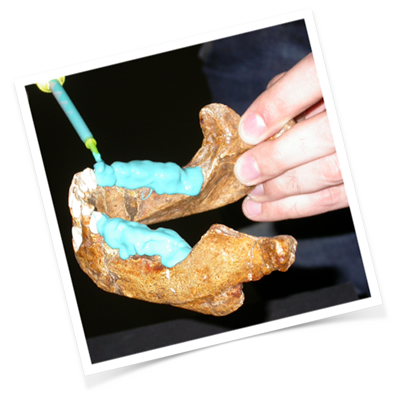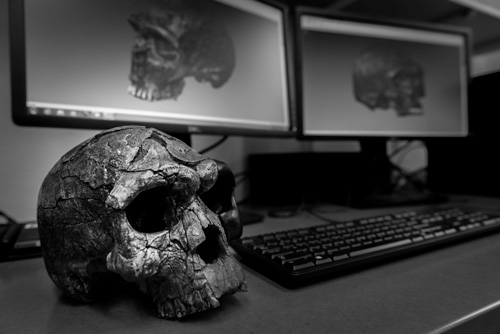Lab
The Palaeodiet Research Lab is a highly multidisciplinary and dynamic team that investigates important biological questions related to humans in an evolutionary context. We are collaborating with major international experts from different fields, ranging from Anthropology to Mechanical Engineering, and from Computer Science to Biogeochemistry. We are located at the Department of Anatomy and Developmental Biology (Clayton Campus at Monash University) and have access to a world-class 3D imaging laboratory.
Methodology
OCCLUSAL FINGERPRINT ANALYSIS
The Occlusal Fingerprint Analysis (OFA) method uses 3D digital surface models of teeth to analyse wear facets and determine their structural parameters: area, perimeter, inclination and orientation. Wear facets are those enamel areas, characterised by a polished surface with well-delimited borders, that are created during attritional contacts between upper and lower teeth that occur during mastication. Three-dimensional data is collected using a white-light scanning 3D system (smartSCAN 3D C-5, Breuckmann GmbH) with a resolution of 45μ. These measurements describe the major movements of occlusal interaction between upper and lower teeth in a 3D space, generating individual occlusal compasses. The occlusal compasses are graphical illustrations that encode and document how contact areas are created and what movements are responsible for their formation. Because of the close relationships between jaw movements, occlusal wear and the physical properties of food, wear facet analyses allow us to reconstruct the dietary habits of fossil or extant species in which tooth-to-tooth occlusion occurs.
Furthermore, in order to better understand how occlusal contacts occur, we use an additional software, called Occlusal Fingerprint Analyser, that simulates the masticatory movements using virtual mandibular trajectories. This software was developed at the Senckenberg Research Institute (Frankfurt, Germany), and, with the help of a powerful collision detector algorithm, is able to reveal all the possible contacts between upper and lower tooth rows starting from a static position.


MOULDING AND CASTING
Generating polygonal models of teeth with white-light or laser 3D scanners faces one major problem, that is the reflection and transparency of the enamel layer. Both scanner systems are in fact, unable to accurately measure the surface information directly from the original tooth. One of the best solutions to overcome this problem is creating high-qualities replicas of teeth that can be later on scanned for generating 3D models. This methodology consists of two distinct phases: moulding and casting. Silicone impression materials are used to produce the negative replicas (or moulds) of the original dentition, that are later on filled with casting materials for the creation of their positive replicas. Dental casts can be of two types: gypsum (or die-stone), which possesses non-reflecting properties, more suitable for 3D digital scanning, and epoxy resins, which are better models for examining finer details, such as microwear surface texture.
FINITE ELEMENT ANALYSIS
Finite Element Analysis (FEA) is a numerical technique wherein a structure with theoretically infinite degrees of freedom is divided into a finite number of discrete elements that are interconnected at nodal points, or nodes. This interconnected network of elements and nodes constitutes the finite element mesh. The mesh is then programmed to contain the material and structural properties, which define how the structure will react to certain loading conditions. Originally developed for the aerospace industry, FEA is a powerful tool in the study of biological systems. It offers insights that could otherwise only be gained through experimental approaches that are impractical, at best, on living subjects, and impossible regarding fossil species. With advances in computer software and imaging technology, FEA has reached a level of sophistication and accessibility that make it a powerful tool in the testing of biomechanical hypotheses in studies of vertebrate form and function.

Facilities
3D IMAGING SOFTWARE
Most of our research is based on the application of high-resolution 3D computer models. We use a wide range of highly sophisticated software, including metrology [such as Geomagic® Control™ (3D Systems, Inc.) and Polyworks® (InnovMetric)], and medical image software for 3D data segmentation [such as Mimics® (Materialise®)], together with engineering (Strand7®, Pty Ltd) and virtual simulation computer tools (Occlusal Fingerprint Analyser). Moreover, we also have access to advanced 3D analysis software (Avizo®, FEI™) through MASSIVE platform (Multi-model Australian ScienceS Imaging and Visualisation Environment).

3D PRINTING

3D DATA ACQUISITION
3D data can be acquired using Computed Tomography (CT) or surface scans (depending on what you want to study and analyse). Here at Monash University we are lucky to have access to state-of-the-art imaging facilities through Monash Biomedical Imaging (MBI) including CT and MRI scanners. Moreover, just next to Monash campus in Clayton, there is the Australian Synchrotron, which could be used to generate high-quality micro-CT data.

CASTING
In our lab we have all the necessary equipment to create very high-quality replicas of teeth in a safe environment, from epoxy to dental stone casts. These facilities include a vacuum chamber (Technomat, Heraeus Kulzer) and a portable ductless fume hood (Captair Flex S321).

COLLECTION
Our anthropological dental cast collections is one of the largest in Australia, and consists of thousands of high-quality replicas (in gypsum and epoxy casts) of living primates, modern humans and extinct hominins, including Australopithecus species, early African Homo and Neanderthals. For most of these specimens we also have high-resolution 3D surface scan models. You are more than welcome to visit the collection and access to the 3D virtual models for research purposes. Please, contact us and tell us about your project.

About
The major goal of the Palaeodiet Research Lab is a better understanding of the relationship between diet, cranio-dental morphology, ecology and evolution in modern humans, our closest living relatives (monkeys and apes) and our extinct ancestors.
Research
The research interests of the Palaeodiet Research Lab mostly focus on functional morphology of the masticatory apparatus in human and non-human primates, and on the importance of the role of diet in human evolution.


